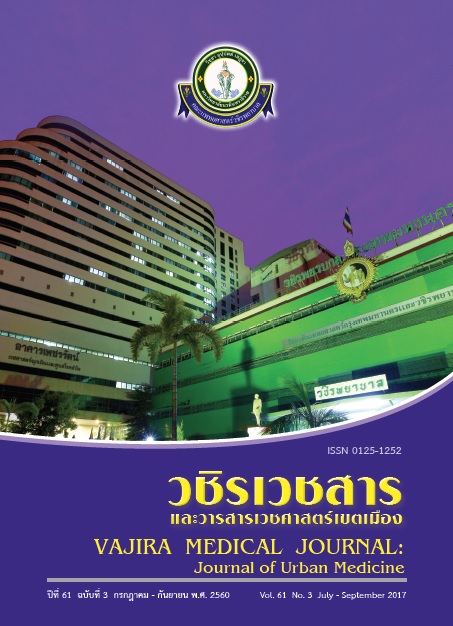Community-based Health Status and Health Service Satisfaction Survey in the Vajira Hospital Neighborhood
Main Article Content
Abstract
Objective: To determine the health status, health service satisfaction, and health service assessment among people in the Vajira Hospital neighborhood.
Methods: This descriptive study was conducted in the Vajira Hospital neighborhood from October 2016 to April 2017. Data were collected by health volunteers using questionnaires with scientific measures, including height scale, body weight, hip circumference, and blood pressure. Data were analyzed as frequencies, percentages, means, and standard deviation (SD).
Results: A total of 911 participants were assessed with an average age of 56.7 years (SD=15.56); most of them were female (68.9%). The average BMI was 25.1 kg/m2 (SD=4.78), average hip circumference was 87.2 cm. (SD=12.43). All participants had chronic health conditions such as hypertension, dyslipidemia, and diabetes respectively. Unhealthy diet, physical inactivity, inadequate sleep and missed annual checkup were found to be high-risk factors. Satisfaction scores of health services obtained from Vajira Hospital were 73.9%. In addition, a center for health counselling was the most needed health services according to targeted communities.
Conclusion: Diseases related to metabolic syndrome tend to have the most adverse effects on the health status of people living in the Vajira Hospital neighborhood. Lifestyle modification may help to reduce the burden, consequences and harm caused by the diseases. The improvement of health services attuned to health demand will increase people’s satisfaction.
Downloads
Article Details
References
2. เทพ หิมะทองคำ. วิกฤตคนกรุงเสี่ยงเบาหวาน ใน มงคล การุณงามพรรณ สุดารัตน์ สุวารี นันทนา น้ำฝน. พฤติกรรมสุขภาพและภาวะสุขภาพของคนทำงานใน สถานประกอบการเขตเมืองใหญ่: กรณีศึกษาพื้นที่เขต สาทร กรุงเทพมหานคร. โรงพยาบาลสงขลานครินทร์. 2555;32(3):51-66.
3. สาธิต คูระทอง, ชาดากานต์ ผโลประการ, จิราภรณ์ ศรีอ่อน, สุเมธ วจนรจนา, ศิริวรรณ ตั้งจิตกมล. เวชศาสตร์เขตเมือง 4.0. เวชศาสตร์เขตเมือง 40. กรุงเทพฯ: บ.เท็กซ์แอนด์ เจอร์นัลพับลิเคชั่น; 2560. p. 6.
4. คณะแพทยศาสตร์วชิรพยาบาล. แผนยุทธศาสตร์ คณะแพทยศาสตร์วชิรพยาบาลปี 2558-2561 (ฉบับปรับปรุงปี 2559) มหาวิทยาลัยนวมินทราธิราช. คณะแพทยศาสตร์วชิรพยาบาล มหาวิทยาลัยนวมินทราธิราช; 2559.
5. Maslow AH. Motivation and personality. New York: Harper & Row; 1970a.
6. Chaplin JP. Dictionary of Psychology. U.K: Penquin Books; 1963.
7. Aday LA, Andersen R. Development of Indices of Access to Medical Care. michigan: Health Administrstion Press; 1975.
8. Woodside AG, Frey LL, Daly RT. Linking Service Quality, Customer Satisfaction, and Behavioral Intention. J Health Care Mark. 1989;9:5-17.
9. กัญญ์สิริ จันทร์เจริญ. การกำหนดประชากรและ กลุ่มตัวอย่าง. การวิจัยทางการพยาบาล: แนวคิดหลักการ และวิธีปฏิบัติ. นนทบุรี: สถาบันพระบรมราชชนก สำนักงานปลัดกระทรวงสาธารณสุข; 2552.
10. WHO. Appropriate body-mass index for Asian populations and its implications for policy and intervention strategies. Lancet. 2004;363:157-63.
11. สถาบันวิจัยและประเมินเทคโนโลยีทางการแพทย์กรมการแพทย์ กระทรวงสาธารณสุข. แนวทางเวชปฏิบัติการป้องกันและดูแลรักษาโรคอ้วน. กรุงเทพฯ: ชุมนุมสหกรณ์การเกษตรแห่งประเทศไทยจำกัด; 2553.
12. Tan C-E, Ma S, Wai D, Chew S-K, Tai E-S. Can We Apply the National Cholesterol Education Program Adult Treatment Panel Definition of the Metabolic Syndrome to Asians? Diabetes Care. 2004;27:1182-6.
13. สถาบันวิจัยประชากรและสังคม มหาวิทยาลัยมหิดล. รายงานสุขภาพคนไทย 2557 [cited 3 กรกฎาคม 2560]. Available from: https://www.thaihealthreport.com/policybrief.
14. กิตติคุณ ยั่งยืน. ภาวะอ้วนลงพุงหรือภาวะเมแทบอลิกซินโดรม. R&D Newsletter. 2559;23:17-20.
15. สมาคมความดันโลหิตสูงแห่งประเทศไทย. แนวทาง การรักษาโรคความดันโลหิตสูงในเวชปฏิบัติทั่วไป พ.ศ.2555 ปรับปรุง พ.ศ. 2558. กรุงเทพฯ:สมาคมความดันโลหิตสูงแห่งประเทศไทย; 2558.
16. พัชรี รัศมีแจ่ม, ปริศนา อัครธนพล, วนิดา ดุรงค์ฤทธิ์ชัย. ปัจจัยทำนายภาวะก่อนความดันโลหิตสูงและความดันโลหิตสูงชนิดไม่ทราบสาเหตุใน ตำบลนาเกลือ อ.สมุทรเจดีย์ จ.สมุทรปราการ. วารสารพยาบาลสาธารณสุข. 2556; 27:102-14.
17. Dhingra R, Sullivan L, Jacques PF, Wang TJ, Fox CS, Meigs JB, et al. Soft drink consumption and risk of developing cardiometabolic risk factors and the metabolic syndrome in middle-aged adults in the community. Circulation. Epub 2007;116:480-8.
18. Pengpida S, Peltzera K. Associations between behavioural riskfactors and overweight and obesityamong adults in populationbasedsamples from 31 countries. Obes Res Clin Pract. 2017;11:158-66.
19. Dib HH, Sun P, Minmin Z, Wei S, Li L. Evaluating community health centers in the City of Dalian, China: how satisfied are patients with the medical services provided and their health professionals? Health Place. 2010;16(3):477-88.
20. รัฐพงษ์ อุดมศรี, สุชีพ พิริยสมิทธิ์. ความพึงพอใจ ในการให้บริการของโรงพยาบาลตำรวจ: กรณีศึกษาแผนกผู้ป่วยนอก [cited 2560 8 กรกฎาคม]. Available from: https://grad.kbu.ac.th/pdf/sar_data/d51_11.pdf.


